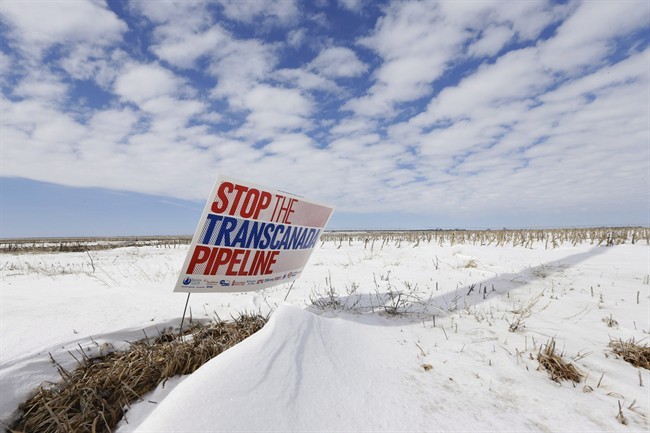CALGARY – A denial of the proposed Keystone XL pipeline would lead to more oil moving across the continent by rail, an executive with pipeline builder TransCanada Corp. said Tuesday, calling such an outcome a “tragedy.”

“While we view rail as a complementary short-term solution until more pipeline capacity is brought online, more rail terminals will be built to fill the capacity gap if Keystone XL is not approved,” Alex Pourbaix, president of energy and oil pipelines, told an investor conference.
VIDEO: Redford’s Keystone XL Washington trip pricetag (Nov 12)
“And I think it’s a real tragedy if this situation continues indefinitely, as pipelines are obviously much more cost-effective. They are statistically safer and more environmentally friendly to transport oil.”
READ MORE: Alberta to keep pushing U.S. on Keystone XL
By the end of 2015, Pourbaix said rail loading capacity in Alberta is expected to double to 800,000 barrels per day – almost as much as the long-stalled Keystone XL pipeline would carry south of the border.
At the same time, Pourbaix said U.S. Gulf Coast rail unloading capacity is expected to exceed 900,000 barrels per day.
MORE: Keystone decision not likely until 2014
All this is happening ahead of a big increase in oilsands production, with Suncor Energy Inc., Imperial Oil Ltd. and Royal Dutch Shell set to collectively add 370,000 barrels per day of new output through new projects in coming years.
TransCanada filed its initial permit for Keystone XL to bring oil to the U.S. Gulf Coast more than five years ago. The pipeline has become one of the more politically divisive issues in the United States today, pitting environmental and landowner interests against national security and economic ones.
VIDEO: Ralph Goodale: Conservatives have ‘dropped the ball’ on Keystone XL (Oct 30)
Some opponents view the pipeline as a major contributor to global climate change, saying it would enable growth in Alberta’s oilsands. Others are focused on local concerns over the impact on land and water in the event of a spill.
READ MORE: Canadian energy ads fail to impress in U.S.
Pipeline supporters would prefer the United States buy its oil from Canada than from unstable regimes elsewhere in the world. They also point to the jobs and other economic benefits the pipeline would bring.
MORE: Anti-Keystone billionaire takes aim at Harper
With Keystone XL and other pipelines mired in regulatory delays, Canadian and U.S. oil producers have been increasingly turning to rail to get their crude to market.
MORE: Pipeline safer mode of transport than rail or truck: Fraser Institute report
But scrutiny over the safety of that mode of transport has intensified after a series of high-profile events this year. Most notably, a train laden with oil from North Dakota’s Bakken region crashed into the town of Lac Megantic, Que., this summer, killing 47 people.
Pourbaix said he does see a role for rail to fill the gap until pipelines are built and that TransCanada could look at opportunities in that line of business.
“We are a ways from announcing anything but … we have really ramped up our business development activities working with rail companies and we’re looking at a number of opportunities in that regard.”
Pourbaix said TransCanada has learned from what has been a frustrating Keystone XL experience as it pursues another major project – its $12-billion Energy East pipeline.
Through a combination of new pipe and repurposed existing pipe, TransCanada aims to send more than one million barrels of crude per day to refineries and export terminals in Quebec and New Brunswick. It expects to file a regulatory application next year.
“I like to think we continue to learn by experience and a lot of the things we’re doing on Energy East, for example, have benefited from our experience in Keystone XL,” said Pourbaix.
A lot of this has to do with how TransCanada deals with communities along the route.
“I cannot tell you how active our team is in getting into these local communities. We spend a lot of time listening, a lot less time talking and we go at it in a very humble manner,” said Pourbaix.
“And I think a lot of those initiatives that we’ve really modified or changed a bit over time are helping us with the support we’re seeing so far. But make no mistake about it – it’s a challenging world.”
As well, Pourbaix says TransCanada will look to share more of the pipeline’s upfront costs with customers so that it’s not on the hook for everything in the event of a delay.
“I don’t think you’ll ever see a situation again where TransCanada is willing to make the commitments that we made on Keystone XL in terms of capital commitments and development costs prior to projects being approved,” he said.
“We’re increasingly seeking to share or place a lot of that cost on our shippers because the costs are just too big and the timeline is such that we think it’s reasonable to share those costs.”



Comments